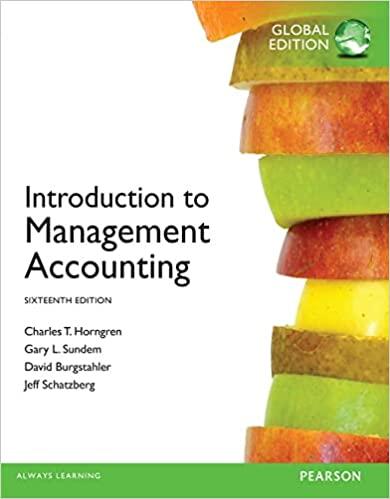Question
Annual cash flows from two competing investment opportunities are given. Each investment opportunity will require the same initial investment. LOADING... (Click the icon to view
Annual cash flows from two competing investment opportunities are given. Each investment opportunity will require the same initial investment.
LOADING...
(Click the icon to view the competing investment opportunities.)
LOADING...
(Click the icon to view the Present Value of $1 table.)
LOADING...
(Click the icon to view the Present Value of Annuity of $1 table.)
Requirement
| 1. | Assuming a 7% interest rate, which investment opportunity would you choose? |
Begin by computing the present value of each investment opportunity. (Assume that the annual cash flows occur at the end of each year. If using present value tables, use factor amounts rounded to three decimal places, X.XXX. Round intermediary computations and your final answer to the nearest whole dollar.)
| The present value of investment opportunity A is |
|
|---|---|
| The present value of investment opportunity B is |
|
Investment opportunity
B
A
should be chosen because the present value of cash flows is
higher
lower
than the present value of investment opportunity
.B
A
|
| Investment A | Investment B |
|---|---|---|
| Year 1 | $14,000 | $9,000 |
| Year 2 | 10,000 | 9,000 |
| Year 3 | 3,000 | 9,000 |
| Total | $27,000 | $27,000 |
| Present Value of $1 | |||||||||
| Periods | 4% | 5% | 6% | 7% | 8% | 10% | 12% | 14% | 16% |
|---|---|---|---|---|---|---|---|---|---|
| Period 1 | 0.962 | 0.952 | 0.943 | 0.935 | 0.926 | 0.909 | 0.893 | 0.877 | 0.862 |
| Period 2 | 0.925 | 0.907 | 0.890 | 0.873 | 0.857 | 0.826 | 0.797 | 0.769 | 0.743 |
| Period 3 | 0.889 | 0.864 | 0.840 | 0.816 | 0.794 | 0.751 | 0.712 | 0.675 | 0.641 |
| Period 4 | 0.855 | 0.823 | 0.792 | 0.763 | 0.735 | 0.683 | 0.636 | 0.592 | 0.552 |
| Period 5 | 0.822 | 0.784 | 0.747 | 0.713 | 0.681 | 0.621 | 0.567 | 0.519 | 0.476 |
| Period 6 | 0.790 | 0.746 | 0.705 | 0.666 | 0.630 | 0.564 | 0.507 | 0.456 | 0.410 |
| Period 7 | 0.760 | 0.711 | 0.665 | 0.623 | 0.583 | 0.513 | 0.452 | 0.400 | 0.354 |
| Period 8 | 0.731 | 0.677 | 0.627 | 0.582 | 0.540 | 0.467 | 0.404 | 0.351 | 0.305 |
| Period 9 | 0.703 | 0.645 | 0.592 | 0.544 | 0.500 | 0.424 | 0.361 | 0.308 | 0.263 |
| Period 10 | 0.676 | 0.614 | 0.558 | 0.508 | 0.463 | 0.386 | 0.322 | 0.270 | 0.227 |
| Period 11 | 0.650 | 0.585 | 0.527 | 0.475 | 0.429 | 0.350 | 0.287 | 0.237 | 0.195 |
| Period 12 | 0.625 | 0.557 | 0.497 | 0.444 | 0.397 | 0.319 | 0.257 | 0.208 | 0.168 |
| Period 13 | 0.601 | 0.530 | 0.469 | 0.415 | 0.368 | 0.290 | 0.229 | 0.182 | 0.145 |
| Period 14 | 0.577 | 0.505 | 0.442 | 0.388 | 0.340 | 0.263 | 0.205 | 0.160 | 0.125 |
| Period 15 | 0.555 | 0.481 | 0.417 | 0.362 | 0.315 | 0.239 | 0.183 | 0.140 | 0.108 |
| Period 16 | 0.534 | 0.458 | 0.394 | 0.339 | 0.292 | 0.218 | 0.163 | 0.123 | 0.093 |
| Period 17 | 0.513 | 0.436 | 0.371 | 0.317 | 0.270 | 0.198 | 0.146 | 0.108 | 0.080 |
| Period 18 | 0.494 | 0.416 | 0.350 | 0.296 | 0.250 | 0.180 | 0.130 | 0.095 | 0.069 |
| Period 19 | 0.475 | 0.396 | 0.331 | 0.277 | 0.232 | 0.164 | 0.116 | 0.083 | 0.060 |
| Period 20 | 0.456 | 0.377 | 0.312 | 0.258 | 0.215 | 0.149 | 0.104 | 0.073 | 0.051 |
Step by Step Solution
There are 3 Steps involved in it
Step: 1

Get Instant Access to Expert-Tailored Solutions
See step-by-step solutions with expert insights and AI powered tools for academic success
Step: 2

Step: 3

Ace Your Homework with AI
Get the answers you need in no time with our AI-driven, step-by-step assistance
Get Started


